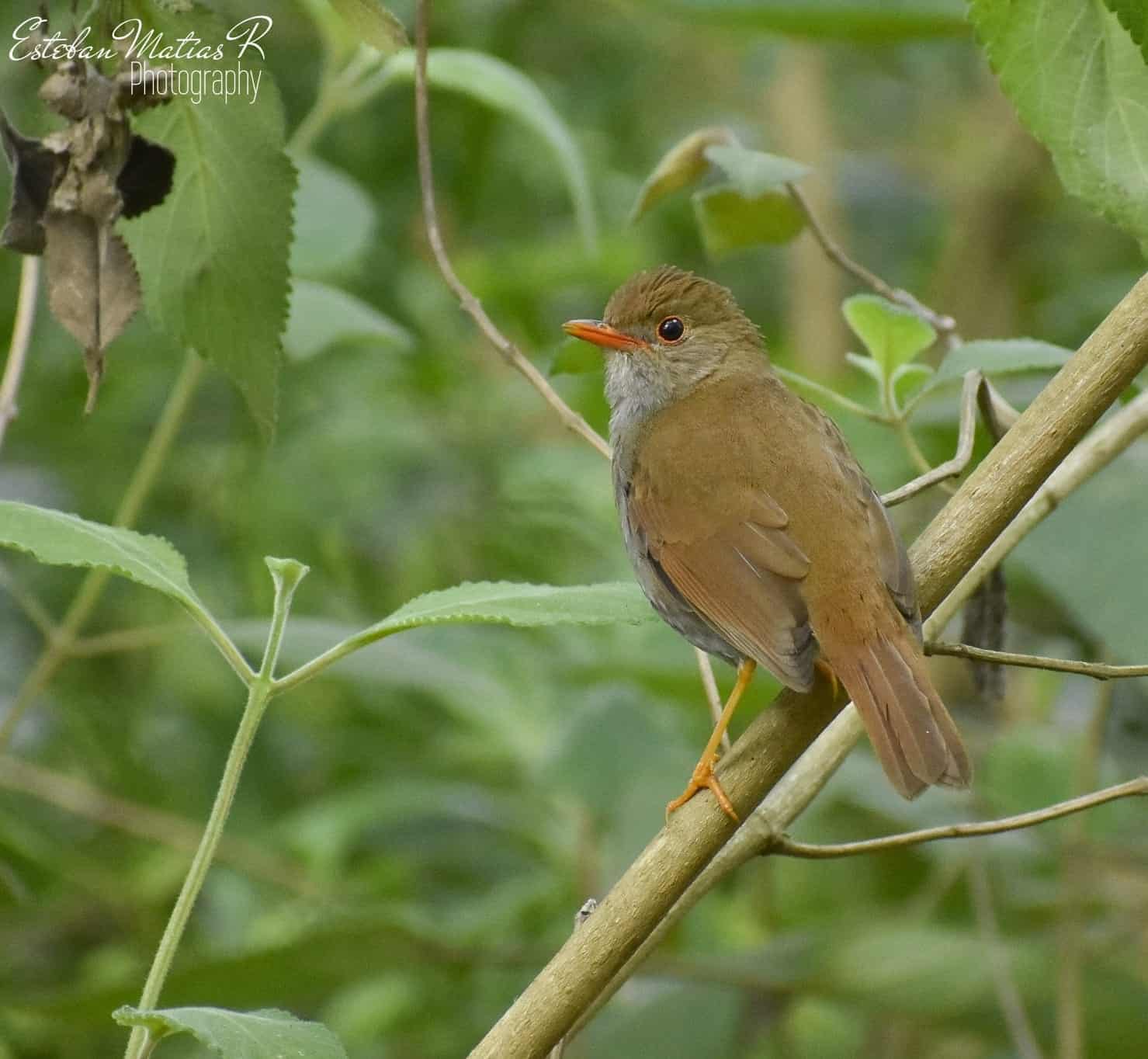Did you spot a bird with an orange beak and wonder what species it is? You’re in the right place! This article includes all birds in North America with orange beaks along with a photo of each, a description of their habitat, nesting, diet, and even a range map.
Below are the 13 species of birds with orange beaks. A few of them are common backyard birds but most of them are waterbirds.
| Bird Species | Type of Bird |
|---|---|
| American robin | Common backyard bird |
| Northern cardinal | Common backyard bird |
| American Oystercatcher | Waterbird |
| Black Oystercatcher | Waterbird |
| Elegant Tern | Waterbird |
| Greater White-Fronted Goose | Waterbird |
| King Eider | Waterbird |
| Mute Swan | Waterbird |
| Northern Shoveler | Waterbird |
| Ridgeway’s Rail | Waterbird |
| Royal Tern | Waterbird |
| Spectacled Eider | Waterbird |
| Surf Scoter | Waterbird |
This article includes the name of these birds along with a photo and description to help you identify them.
I’ve been studying birds and hosting backyard birds for more than 20 years so researching and collecting information about orange-beaked birds was a lot of fun for me. I know the information you need to make an accurate ID and have included it all in this article.
My hope is that this article will help you easily identify the species of bird you’re interested in. So let’s get at it, here are the birds with orange beaks:
Common Backyard Birds with Orange Beaks
American Robin
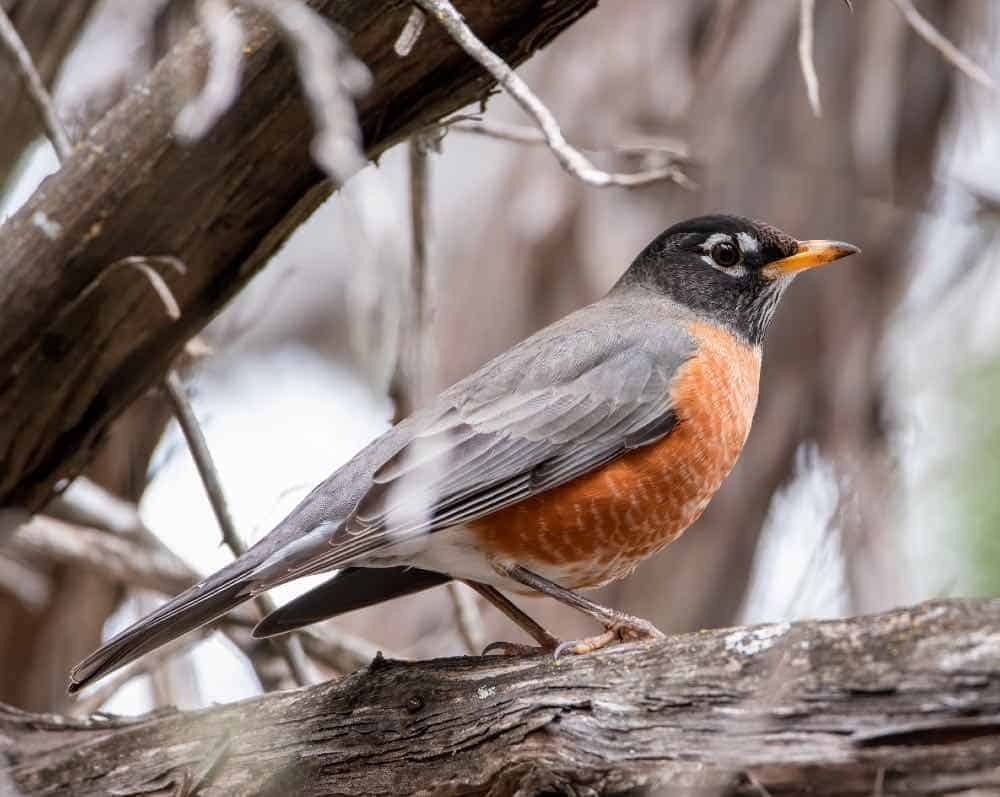
Appearance: The American robin is a medium-size bird about 10″ long, with gray/brown upper, brown/orange underparts, yellow beak, white chin, and white surrounding eyes. orange beak. The Female has a lighter head and underparts.
Diet: Earthworms, insects, and fruit.
Feeder food: Not a feeder visitor.
Habitat: Common and pervasive throughout US and Canada. Found in fields, parks, wooded and forested areas, mountains, and backyards.
Nesting:
- Nest: Nesting sites vary from the lower half of a tree to rain gutters, outdoor lights, and more.
- Broods: 1-3 broods/season,
- Clutch: 3-5 eggs/brood,
- Egg color: Bright sky blue or blue-green, without spots
- Egg size: 1.1″ long x 8″ wide
- Incubation: 12-14 days.
Migration: American robins are migrators.
Year-round range: Every US state except North Dakota, southern parts of Canada’s British Columbia, and Alberta, as well as Mexico.
Breeding range: Canada and Alaska.
Winter range: While most American robins head south back to the year-round range, others will go further into the far southern parts of Florida, California, Arizona, New Mexico, Texas, Louisiana, and Mexico.
Range Map
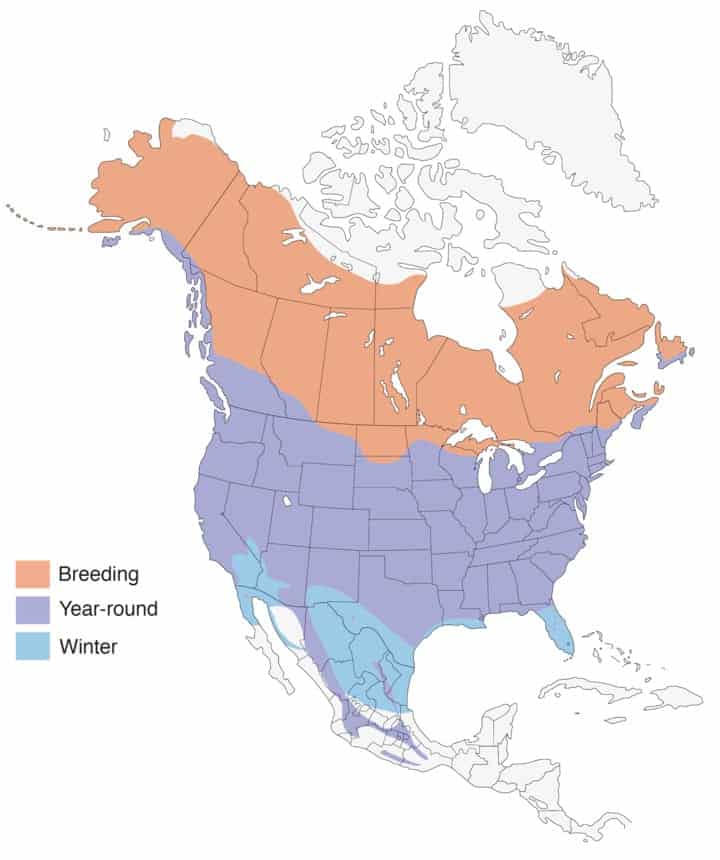
Northern Cardinal
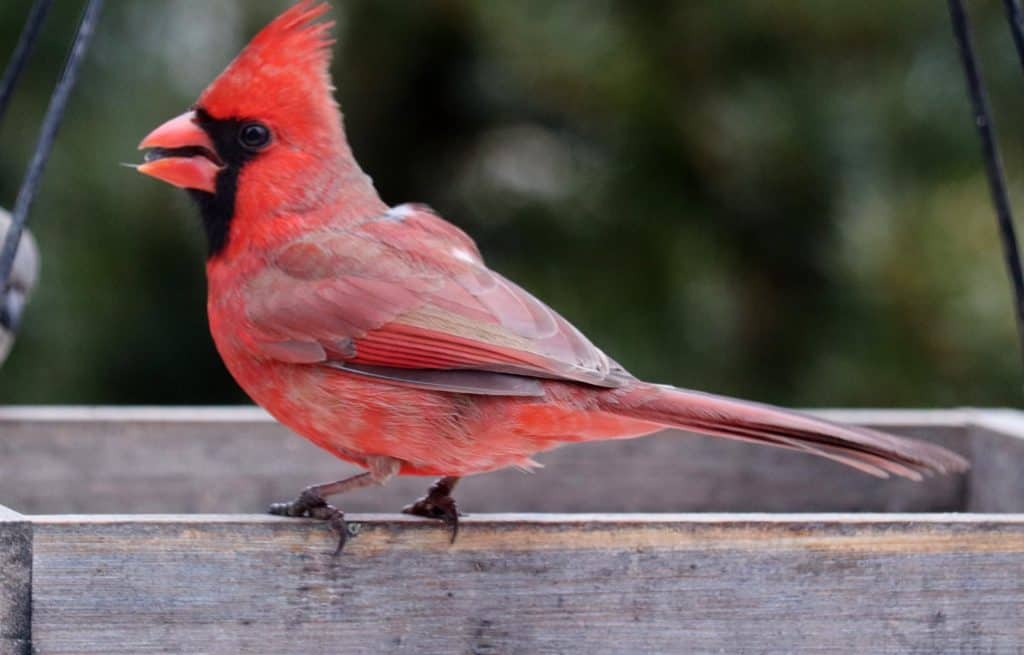
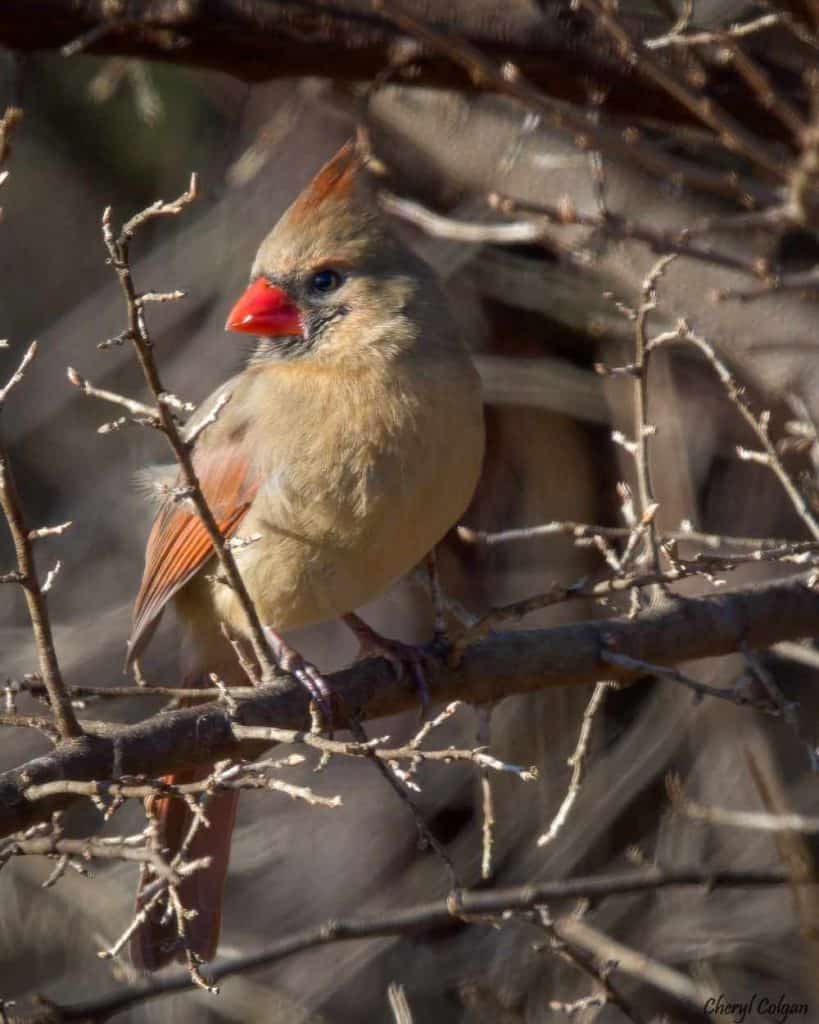
Appearance: Northern cardinals are medium-sized bright red birds about 8 1/2″ long with a black mask, red crown, orange beak, and black areas on wings and tail. The female also has an orange beak but her body is buffy brown with tinges of red on her wings, tails, and crest. The mask around her fact is charcoal.
Diet: Insects, spiders, centipedes, snails, and slugs. Fruit and seeds from plants.
Feeder food: Black-oil sunflower seed, safflower seed, mealworms, striped Sunflower seed, hulled peanuts, and cracked corn.
Habitat: Edges of wooded areas to thickets, tangled vines, city parks, and our backyard gardens.
In the southwest live around desert washes, areas thick with mesquite, and along the riverbanks of wooded areas.
Nesting: Open-cup nest in a dense shrub about 3-10′ up. They have 2-3 broods/year, and 1-5 eggs/brood that are beige with brown spots. Incubation is 12-13 days.
Migration: Northern cardinals are not migrators. They remain in their year-round range every season of the year.
Year-round range: Eastern half of the US, Arizona, New Mexico, and Mexico.
Range Map
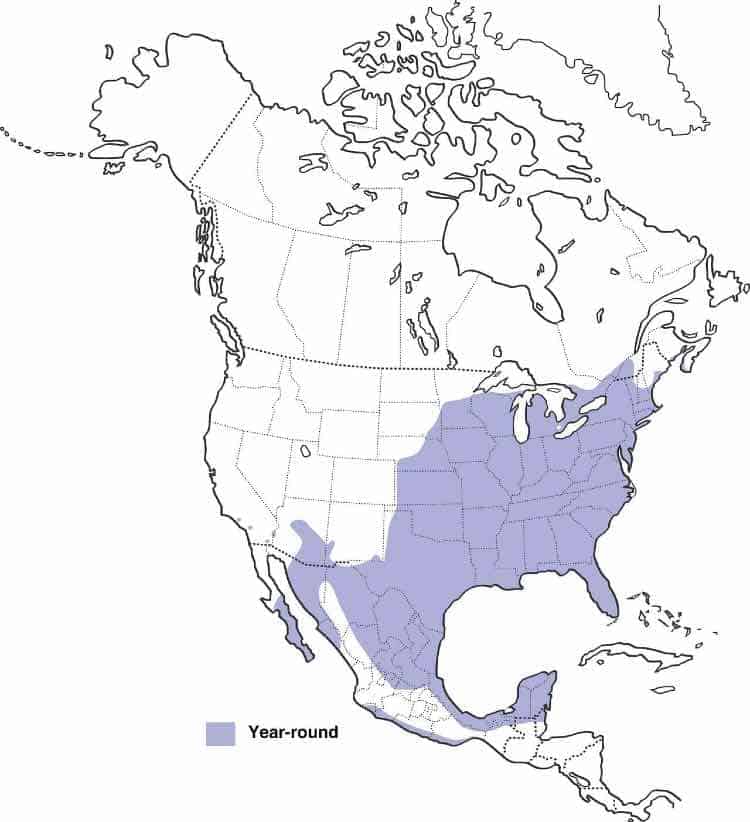
Waterbirds with Orange Beaks
American Oystercatcher
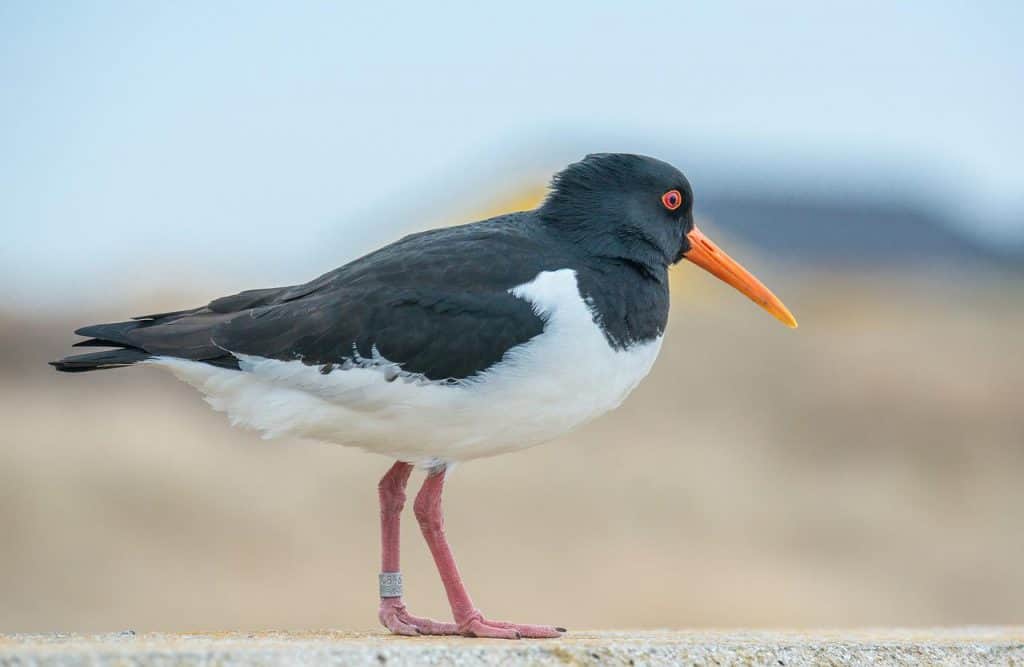
| Appearance | The American oystercatcher is a medium-sized shorebird about 16″ long. They’re black above, white below, and have a deep orange bill, yellow-orange eyes, and pink legs. |
| Diet | Mollusks, limpets, jellyfish, starfish, and other marine life. |
| Feeder Food | N/A |
| Habitat | Interditadl areas along the beach and barrier islands. Sandy, salt marshy areas are preferred. |
| Nesting | The American oystercatcher uses a simple nest laying in the sand without any lining. Broods: 1/season Clutch: 2-4 eggs/brood Egg color: light gray with brown spots Egg size: 2.25″ x 1.55″ Incubation: 24-28 days. |
Range Map
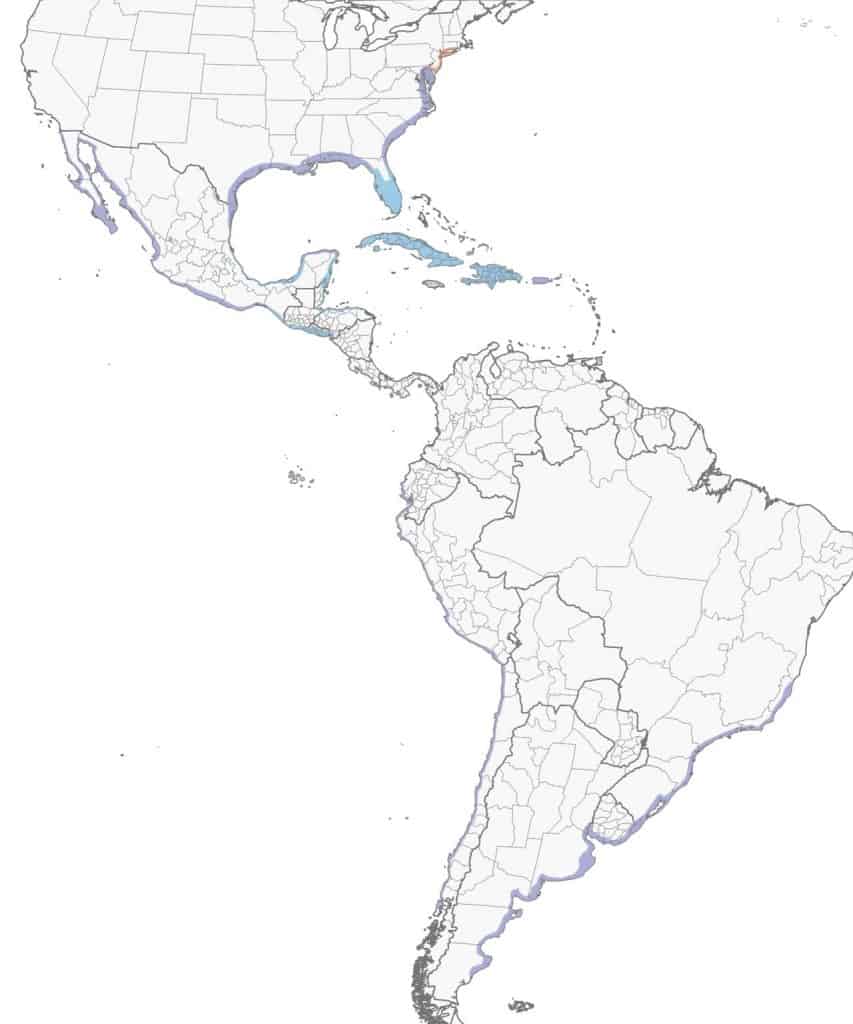
Black Oystercatcher
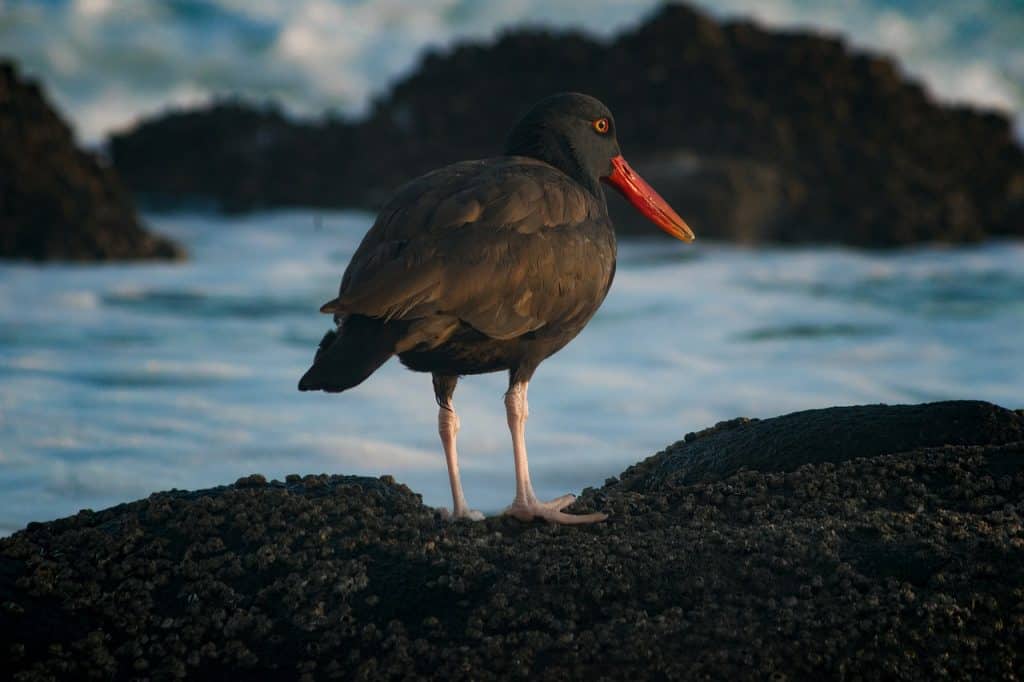
| Appearance | The black oystercatcher is a large shorebird about 17″ long. They’re all black with a long, thick, straight orange-red bill, orange-yellow eyes, and pale pink legs. |
| Diet | Mollusks and shellfish |
| Feeder Food | N/A |
| Habitat | Along the rocky shores of the pacific ocean. |
| Nesting | Nests are built along the rocky shores and are relatively bare. They may consist of small rocks or shells that are relatively shallow – 1″. Clutch: 2-3 eggs Egg color: creamy white to olive with spots Incubation: 24-29 days |
Range Map
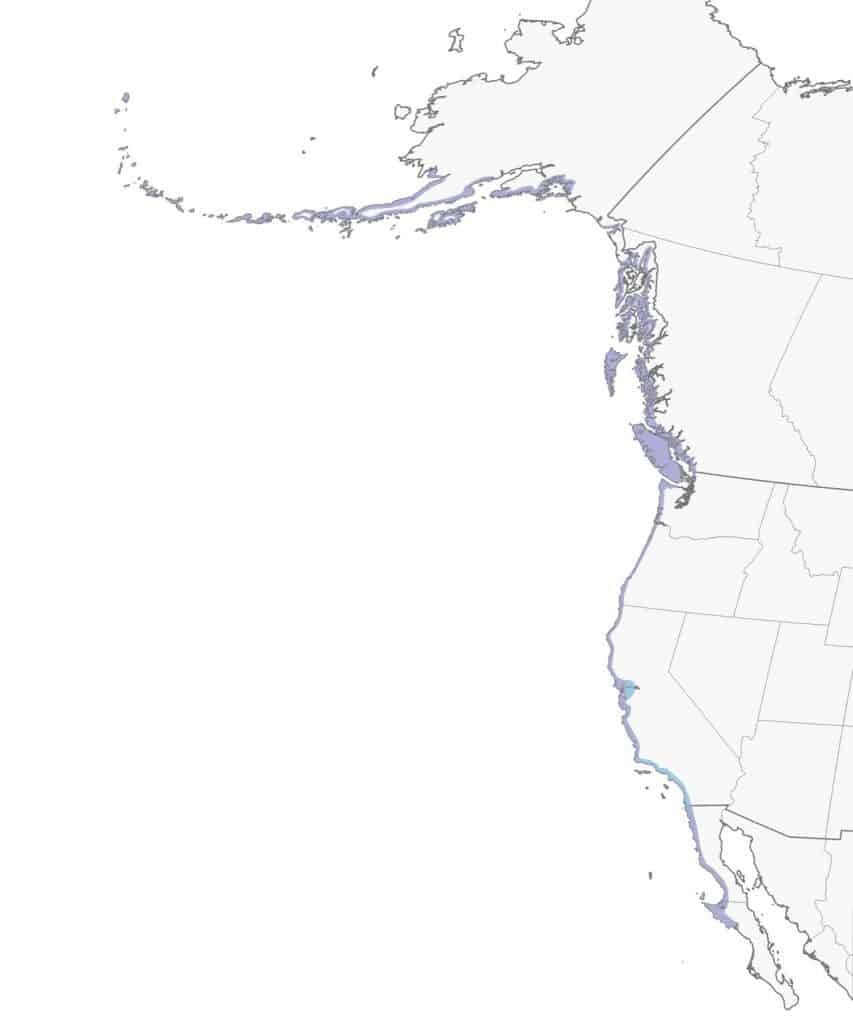
Elegant Tern
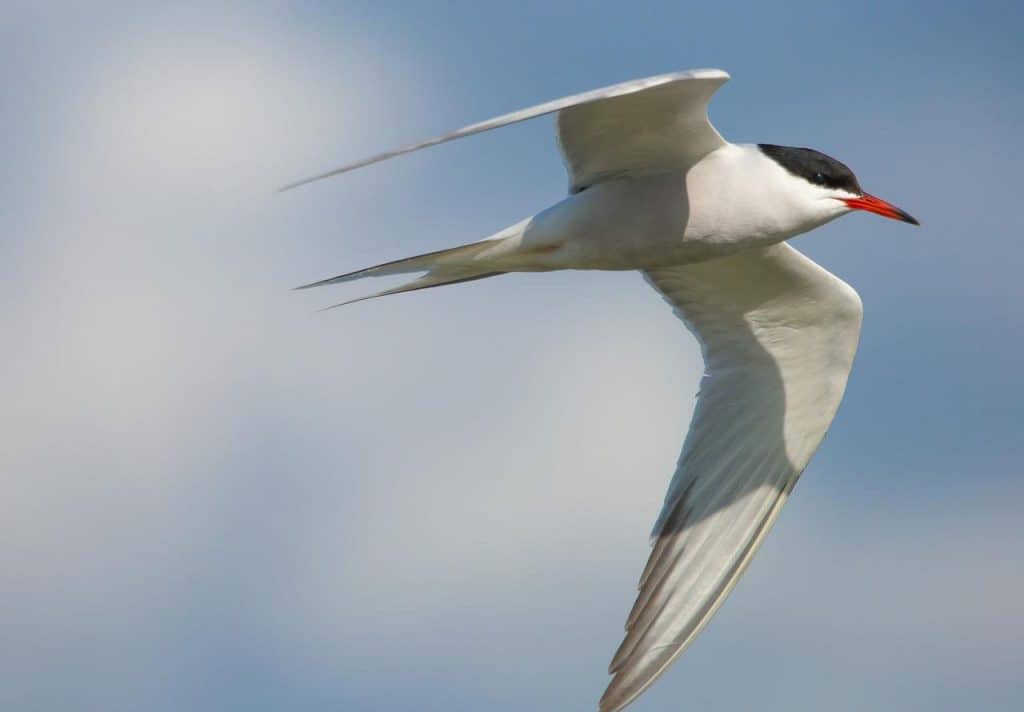
| Appearance | The elegant tern is a large waterbird about 15 – 17″ long. They’re pale gray with medium gray wings, a ragged black crest, a long, thin, pointed orange bill, and black legs. |
| Diet | Fish |
| Feeder Food | Does not visit feeders. |
| Habitat | Beaches and sandy islands along the west coast from Oregon south to South America. |
| Nesting | The elegant tern nests on the ground along the beach. Both parents build the nest using shells, pebbles, sand, and other objects found. Broods: 1/year Clutch: 1-2 eggs/brood Egg color: White to pale pink and spotted. Incubation: 26 days on average |
Range Map
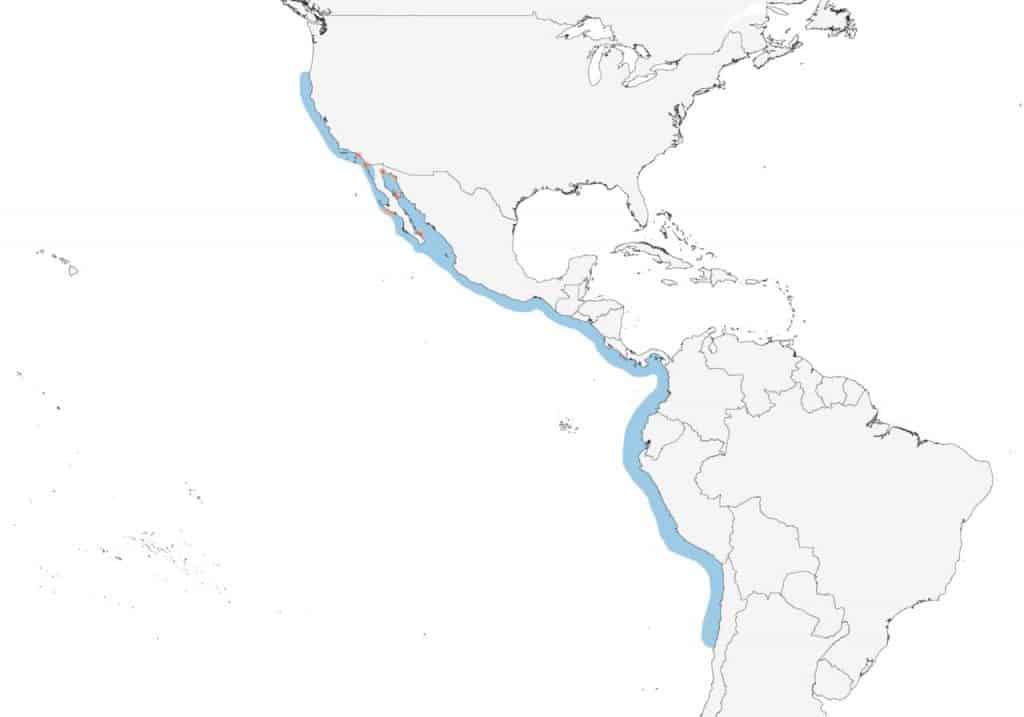
Greater White-Fronted Goose
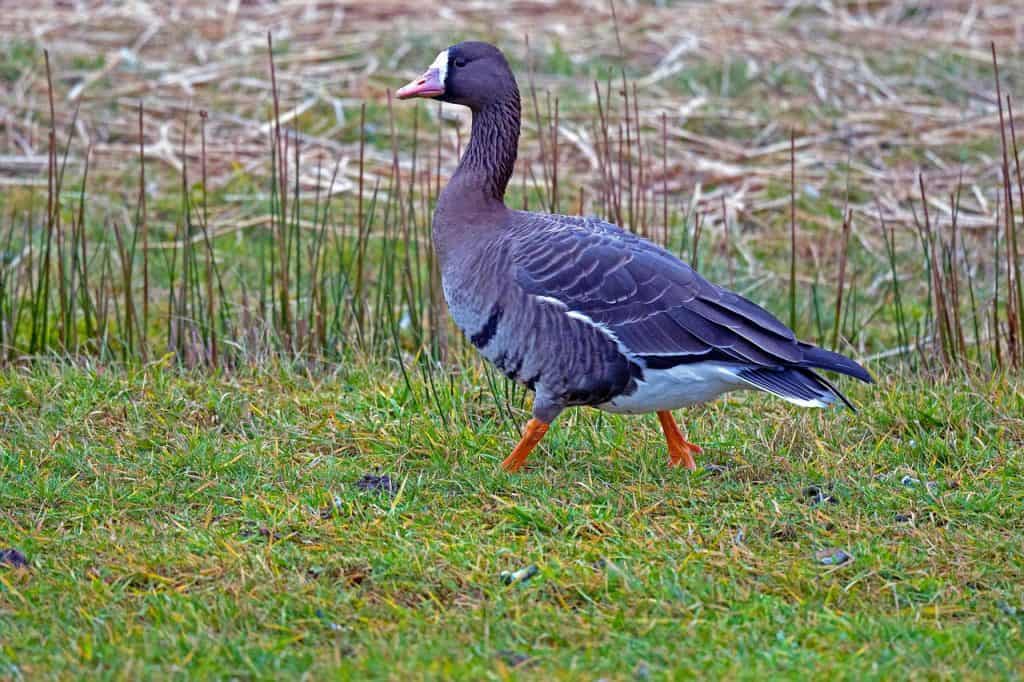
| Appearance | Large mostly brown waterbird about 25-32″ long. They have a heavy, stocky body with an orange bill and legs, white between the bill and head, and buffy underparts. |
| Diet | Diet includes plants such as grasses, berries, seeds, and grain. |
| Feeder Food | N/A |
| Habitat | Near wetlands, rivers, and ponds. |
| Nesting | The greater white-faced goose is a ground nester. The female constructs the nest on the shore of a lake or wetland area. She scrapes the ground and incorporates grass and sedge to form a large bowl-shaped nest. Broods: 1/season Clutch: 1-8 eggs/brood Egg color: white – tan Egg size: About 3.2″ x 2.1″ Incubation: Incubation lasts about 22-27 days and fledglings leave the nest after a short 2 days. |
| Migration | Greater white-fronted geese are migrators. In spring they migrate north into the northernmost part of Canada and Alaska to breed and raise young. Then in the fall, they head south and west for the winter. Breeding range: Alaska, and Canada’s northern Yukon, Northwest Territories, and Nunavut. Winter range: Along the pacific northwest from Washington to Mexico, southeastern Texas, Louisiana, and southeastern Arkansas. |
Range Map
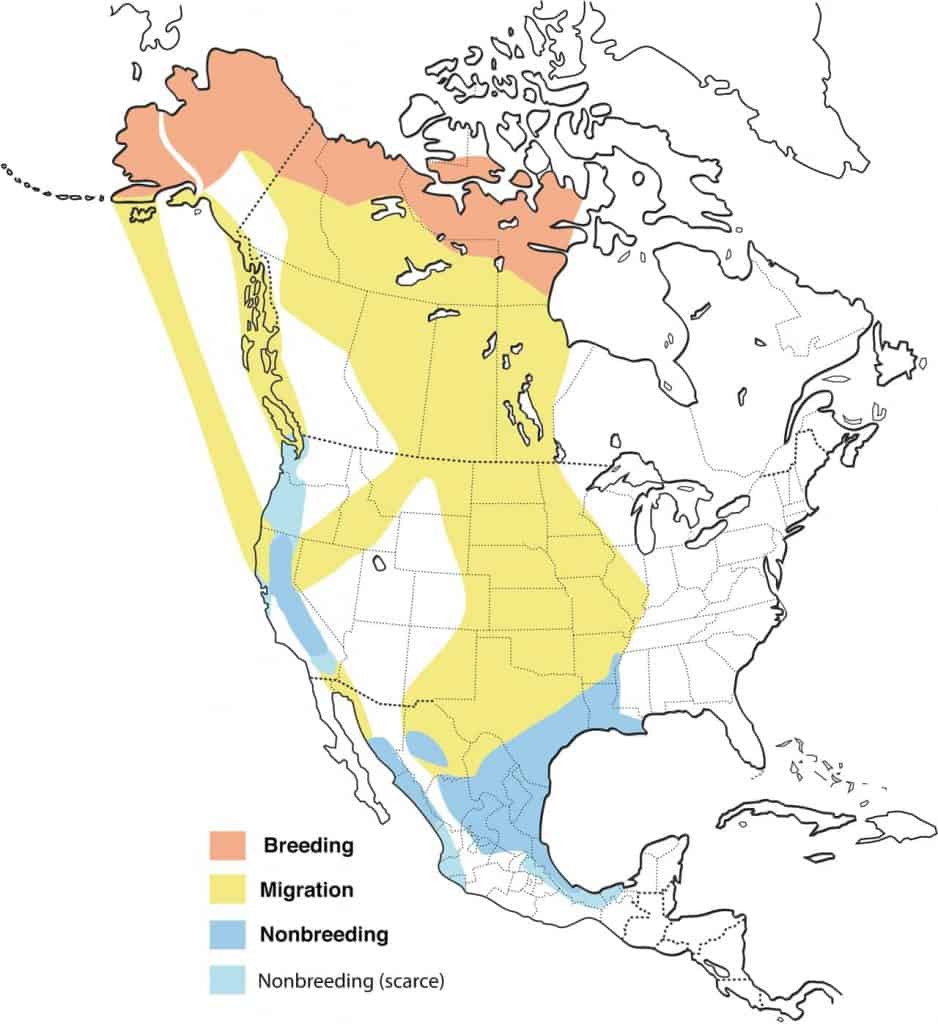
King Eider
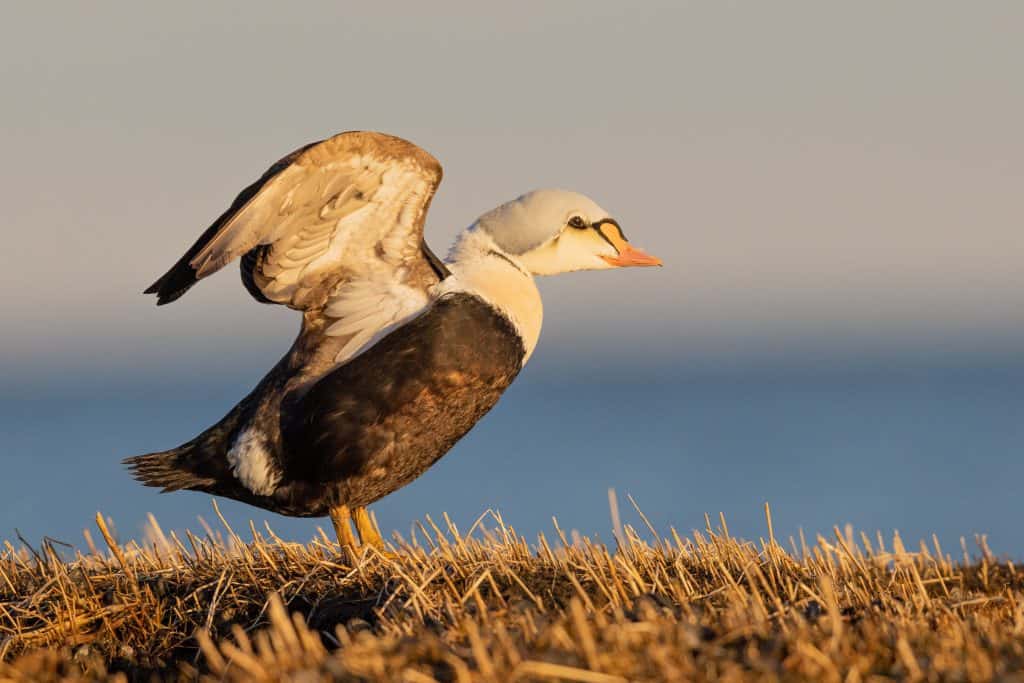
| Appearance | The male king eider has a very unique watercolor appearance. His body is primarily black with a white head and chest. The head is further colored with shades of orange on its front, shades of green on the cheeks, and a bright orange bill. The female is an ordinary, dull brown throughout and a black bill. |
| Diet | Mollusks, shellfish, crustaceans, algae, insects, and plants. |
| Feeder Food | N/A |
| Habitat | Open, treeless, and often rocky areas beside the ocean coast, wetlands, and lakes. |
| Nesting | They are ground nesters. The 10″ wide nest is comprised of ground soil and later adorned with the female’s own down. Clutch: 3-7 eggs Egg color: olive to pale olive Egg size: Unknown Incubation: Incubation is for 22- 24 days. Fledglings leave the nest within days to practice flying which can take up to 50 days. |
Range Map
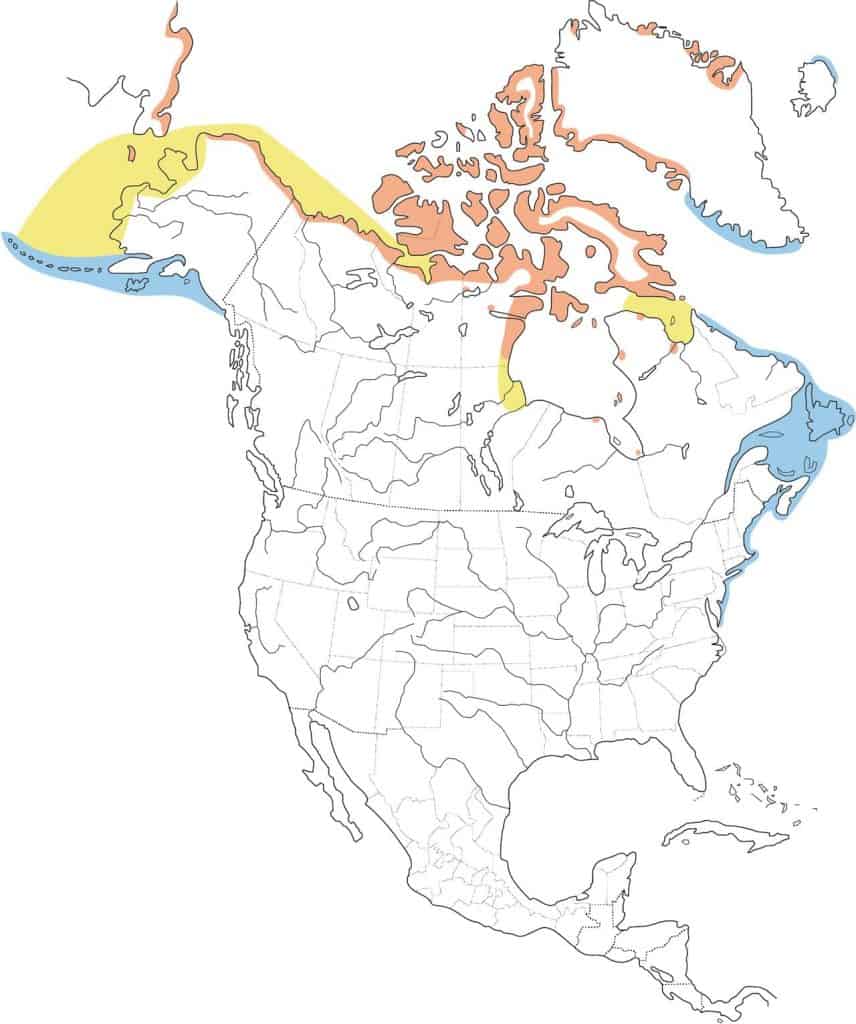
Mute Swan
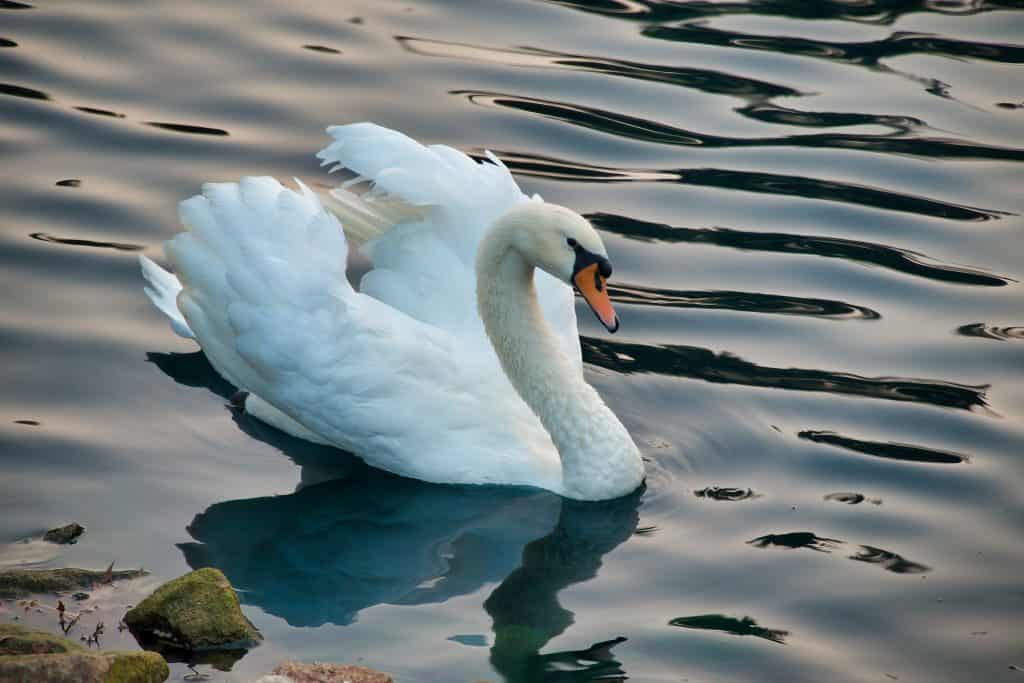
| Appearance | Mute swans are enormous waterbirds at about 50-60″ in length. They’re white with an orange bill and black at the base of the bill on the face. |
| Diet | Fish and plant material |
| Feeder Food | N/A |
| Habitat | Mute swans are found floating on the water in urban ponds (parks), lagoons, rivers, lakes, and coastal areas where saltwater meets freshwater rivers and streams. |
| Nesting | Mute swans are ground nesters. They construct the nest on beaches, dikes or even on nearby islands. Clutch: 5-7 eggs/brood on average Egg color: pale green Incubation: Incubation is about 36 days. The young fledge after about 4-5 months. |
Range Map
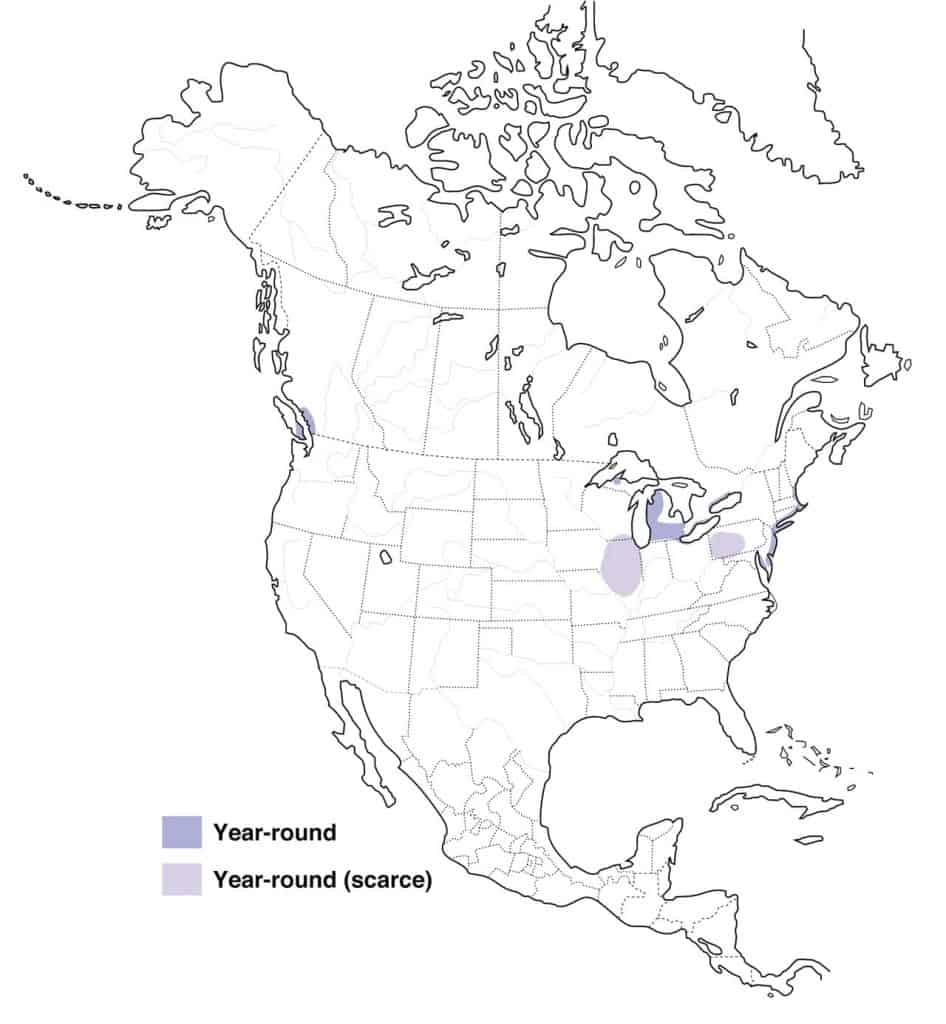
Northern Shoveler
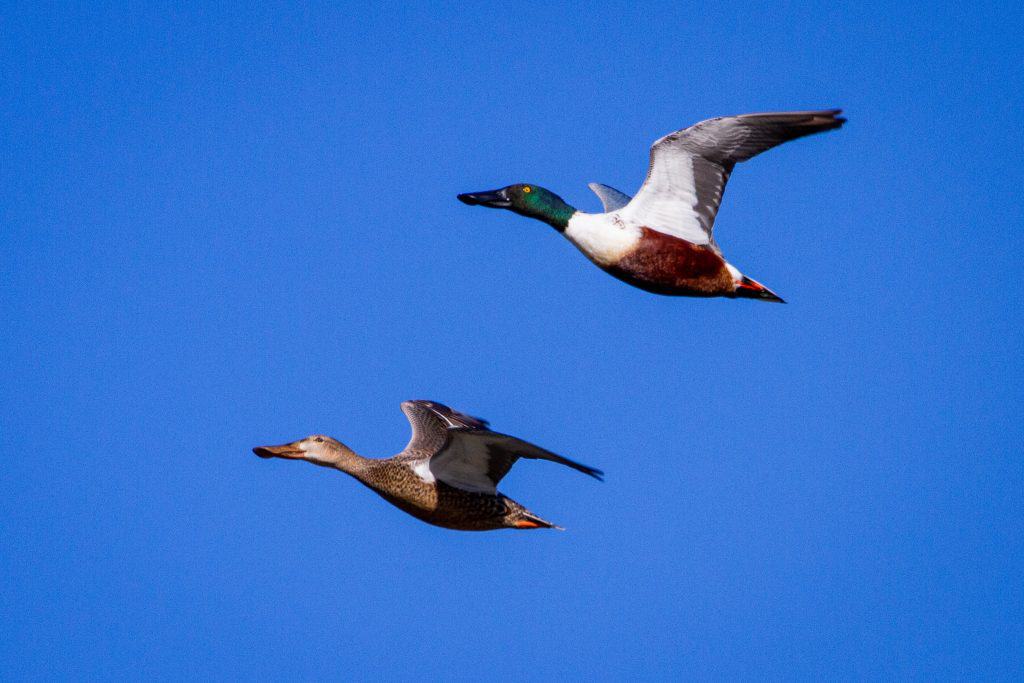
| Appearance | Northern shovelers are medium-sized waterbirds at about 17-20″ in length. They have shovel-shaped heads. The male has a dark green head, black back and feathers, white neck, and brown chest. The female has an orange bill & eggs with brown and white markings throughout her body. |
| Diet | Mollusks, insects, crustaceans, sometimes small fish, aquatic plants, and seeds. |
| Feeder Food | N/A |
| Habitat | Northern shovelers can be found in shallow wetland areas with plenty of vegetation. They’ll also be found in salt marshes, lakes, flooded fields, and other overflow areas that collect water. |
| Nesting | Northern shovelers are grounds nesters. The female generally Broods: 1 broods/season Clutch: 8-12 eggs/brood Egg color: pale olive Egg size: About 2″ x 1.4″ Incubation: Incubation lasts 21-27 days. The young follow their mom out of the nest within a few hours of hatching. They’re able to fly about 52-60 days after hatching. |
Range Map
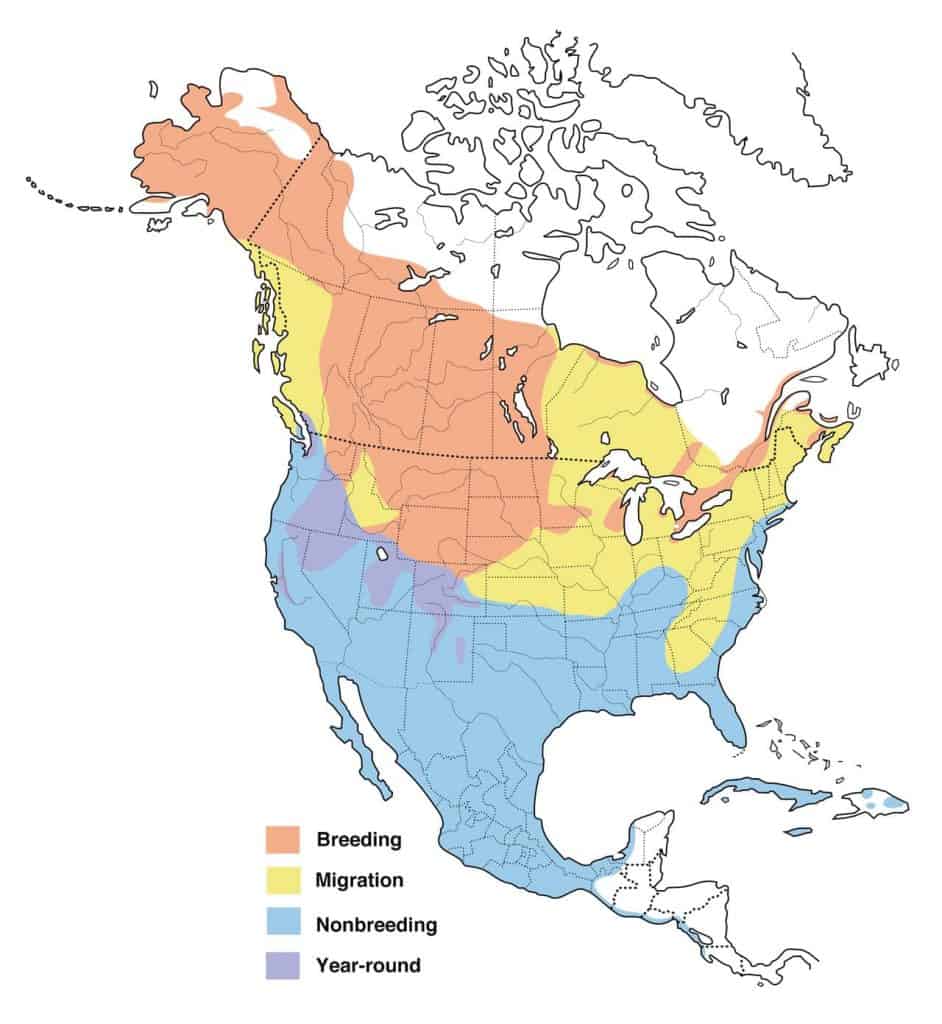
Ridgway’s Rail
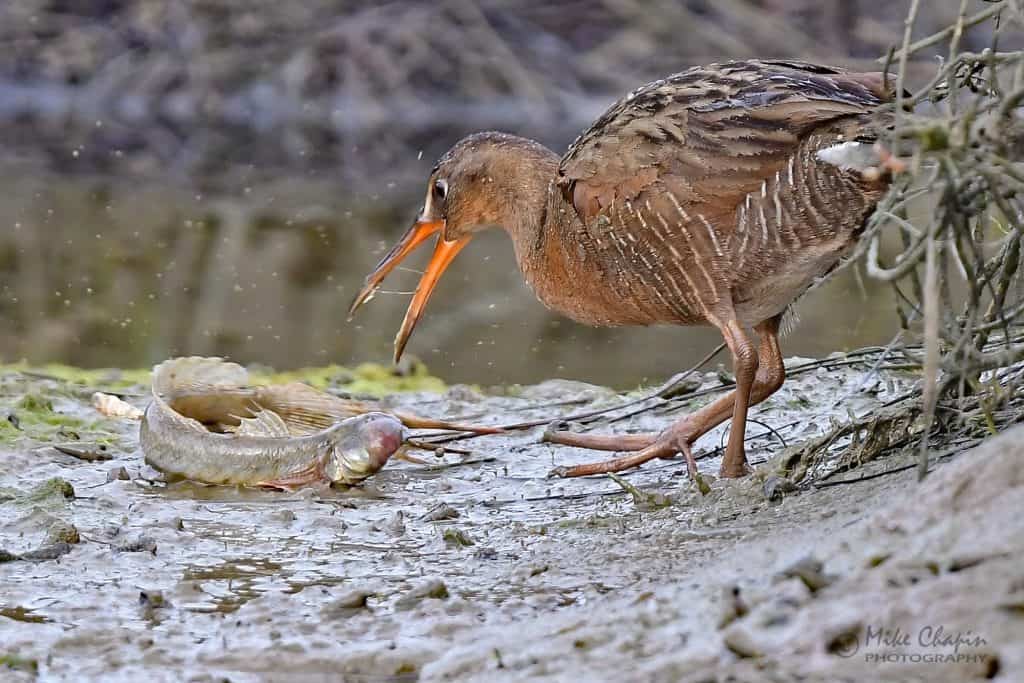
| Appearance | Ridgeway rails are large brown waterbirds with a distinctive long, pointy orange bill. |
| Diet | Crustaceans, crayfish, aquatic insects, small fish, mollusks, worms, frogs, and seeds. |
| Feeder Food | N/A |
| Habitat | Salt marshes along the US west coast south to Mexico. |
| Nesting | The nest is located in a clump of grass above high tide or on a water bank. The male constructs the nest using grasses and sedges. A canopy is often constructed over the nest. Clutch: typically 7-11 eggs Egg Color: Pale yellow – light olive Incubation: Both males and females incubate the eggs for about 23-29 days. The young can fly at about 9-10 weeks. |
Range Map
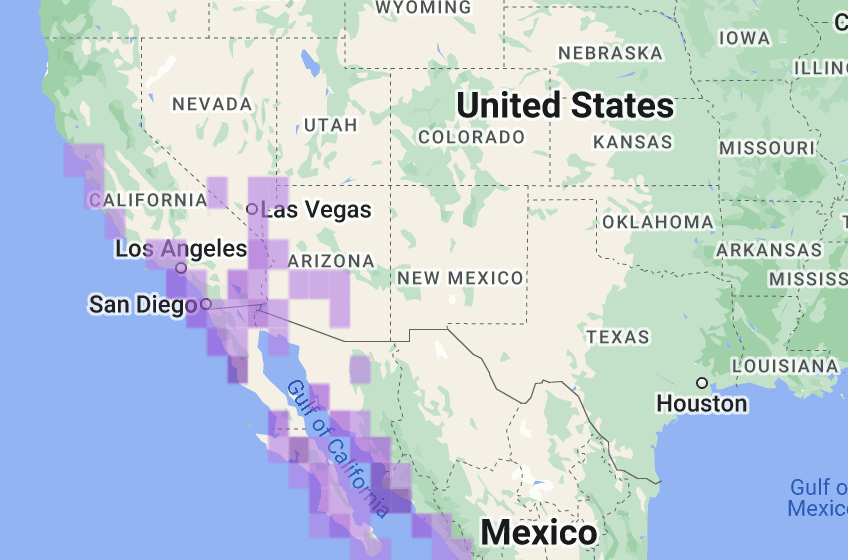
Royal Tern
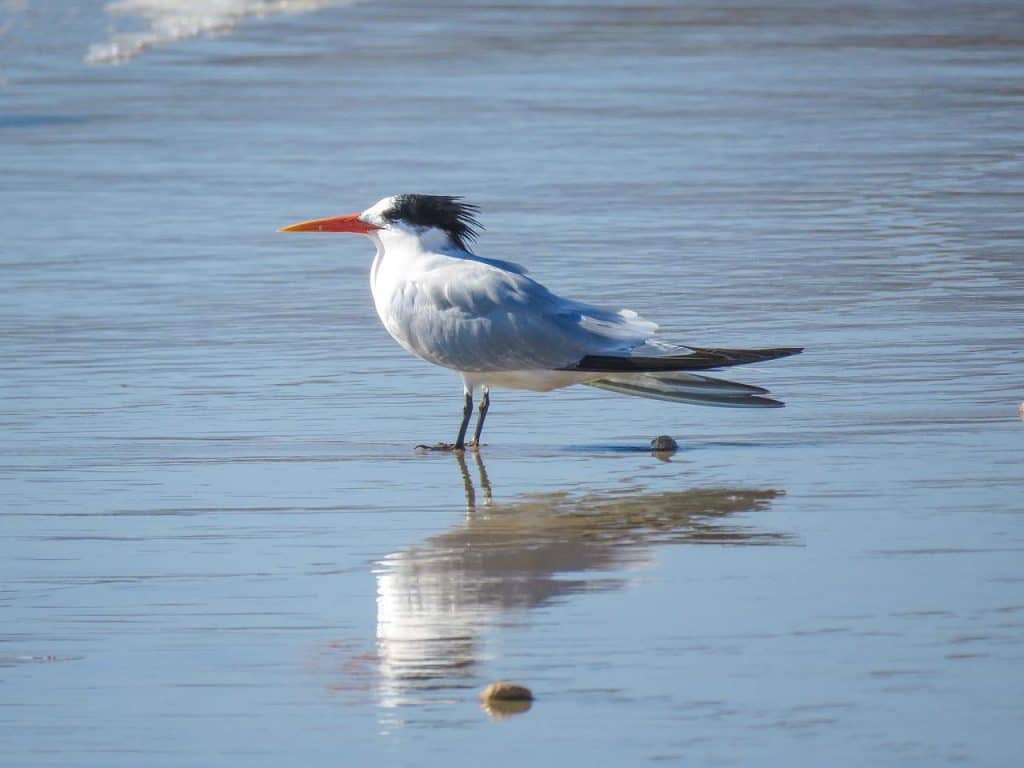
| Appearance | The royal tern is a squatty waterbird about 18″ long with a black crest, bright orange bill, gray above, and white underparts. |
| Diet | Fish, crustaceans, and fish. |
| Feeder Food | N/A |
| Habitat | Shallow, coastal waters and rivers near shore. |
| Nesting | Royal terns are ground nesters. They dig a shallow hole in the sand. Broods: 1 brood/season Clutch: 1-2 eggs/brood Egg color: White/brown with reddish/brown spots Incubation: Incubation is for about 28-35 days. Within 2-3 days after hatching the young leaves the nest. After about 4-5 weeks they’ve taken their first flight. |
Range Map
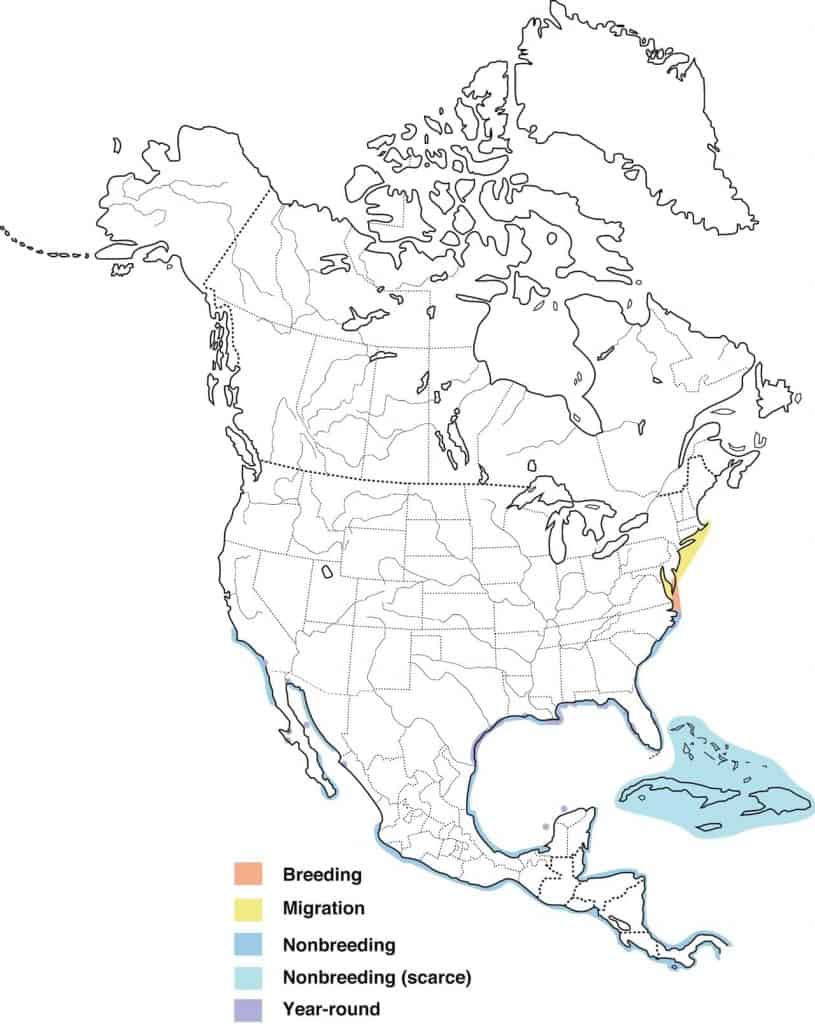
Spectacled Eider
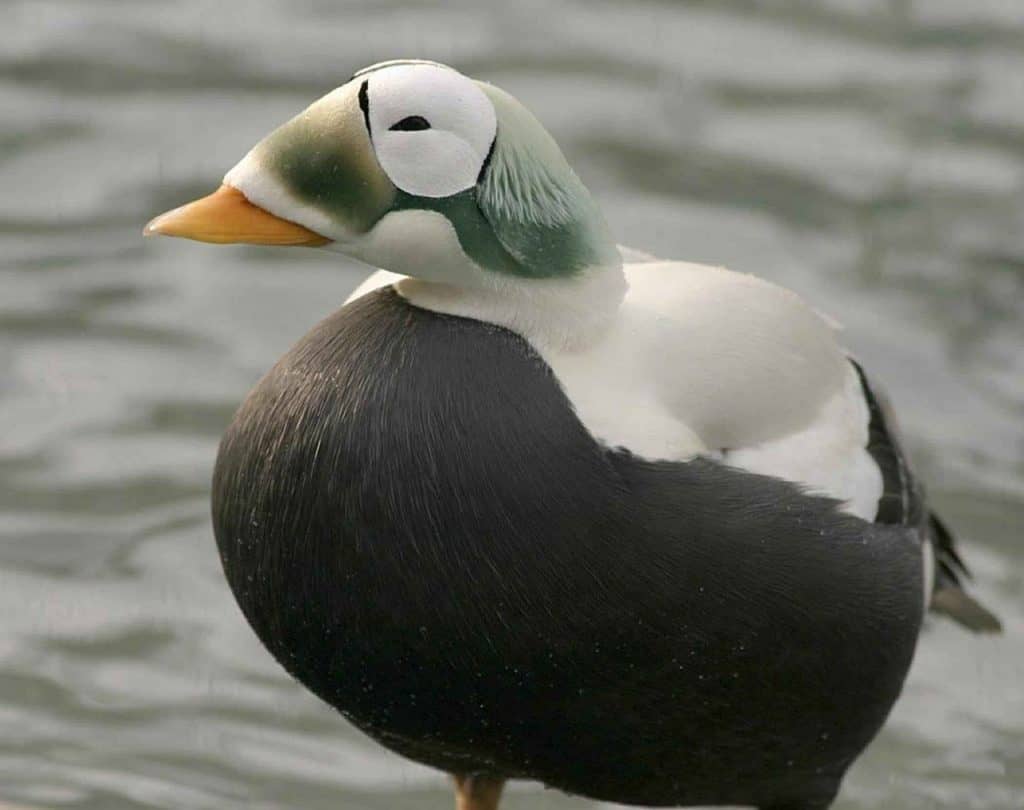
| Appearance | The spectacle eider is a mysterious-looking medium-sized water bird about 20″ long. The male has a white back, black underparts, white feathers, an orange bill, a long sloping forehead, varying shades of green around the head, and white round “spectacles” around each eye. The female is similar except she’s a dull brown. |
| Diet | Mollusks, aquatic insects, crustaceans, and plant material. |
| Feeder Food | N/A |
| Habitat | Wet ocean tundra regions on the west coast of Alaska. |
| Nesting | The female constructs the nest by creating a shallow depression along the edge of a water source. It’s lined with down and other plant materials. Clutch: 3-9 eggs Egg color: pale olive Incubation: The female incubates for about 24 days. The young leave the nest soon after hatching. Their first flight takes place about 53 days later. |
Range Map
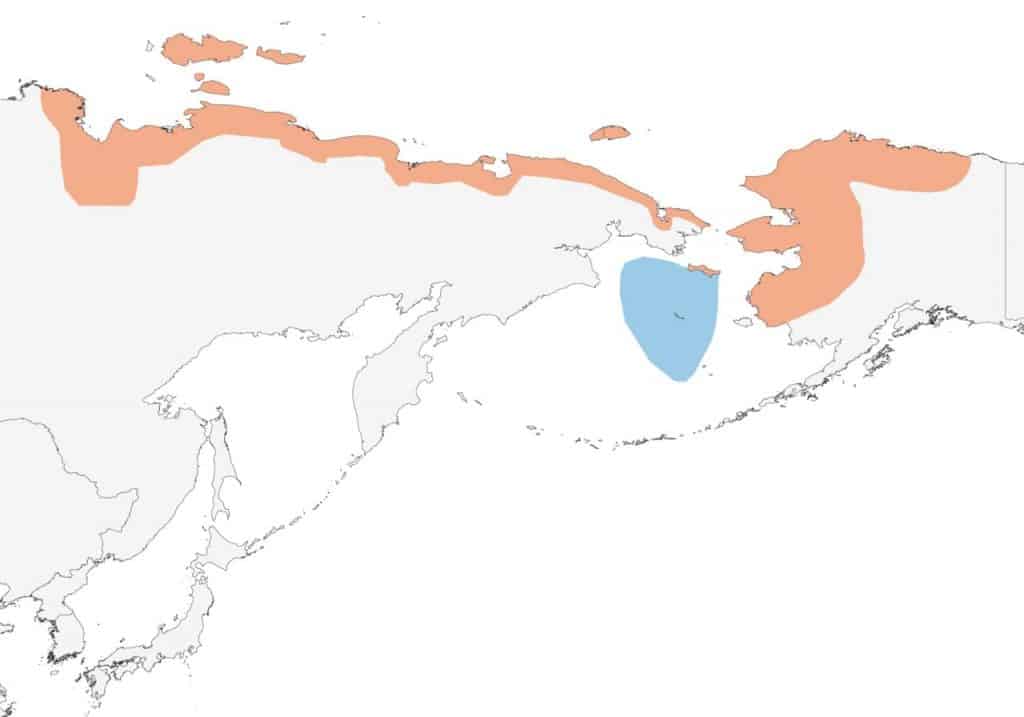
Surf Scoter
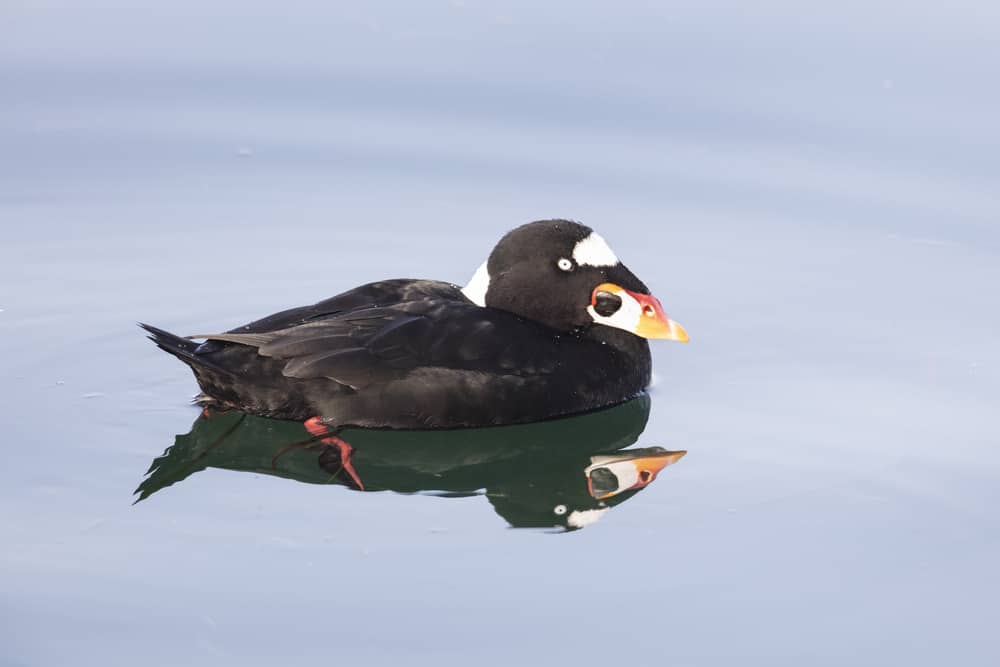
| Appearance | Surf scoters are medium-sized ducks about 19″ – 24″ in length. The male is black and has a large, sloping forehead with patches of white (on the back of the neck, forehead, and either side of the upper bill), and an orange bill. The female is brown with subtle white patches on her face. |
| Diet | Marine life including mollusks, snails, crabs, hydrozoans, worms, herring spawn, echinoderms, and aquatic plants. |
| Feeder Food | N/A |
| Habitat | Surf scoters are commonly found along the ocean surf, salt bays, wetlands, lakes, tundra, forests, shrublands, and even meadows. |
| Nesting | Surf scoters are ground nesters. They construct the nest under low tree branches over 100′ from the shores. She builds a shallow depression and lines with her own down and other grasses. Clutch: 5-9 eggs/brood Egg color: pale buff Incubation: The female incubates the eggs for an unknown period of time. After hatching, the young follow their mother to the water. |
Range Map
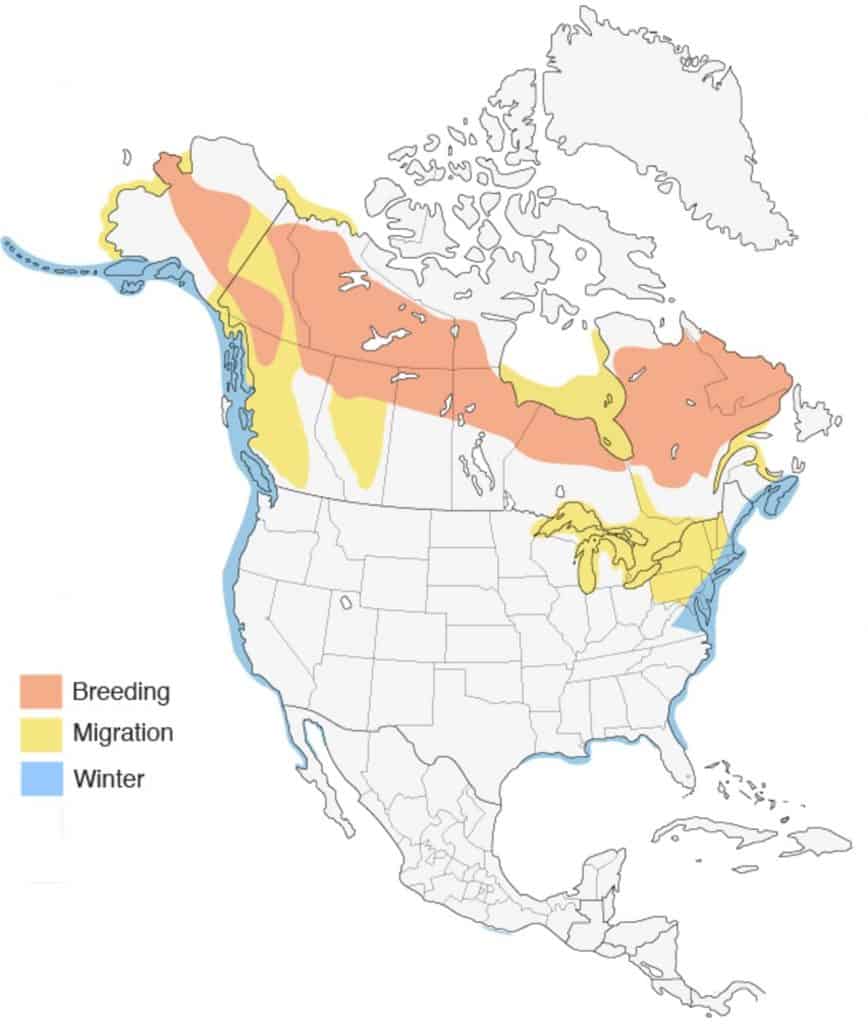
Conclusion
North America doesn’t have a lot of birds with orange bills but the ones that do live here are fascinating (especially the waterbirds!). Hopefully, you’ve identified the one you’re interested or at least learned a thing or two about the bird species with orange beaks.
Happy birding!

